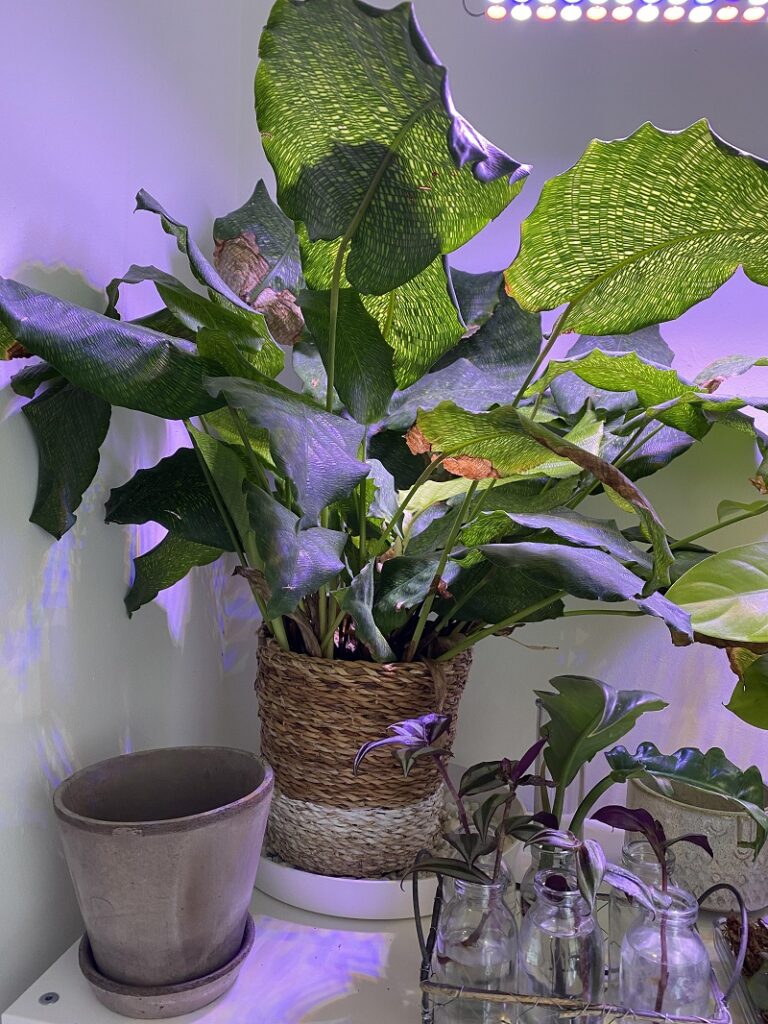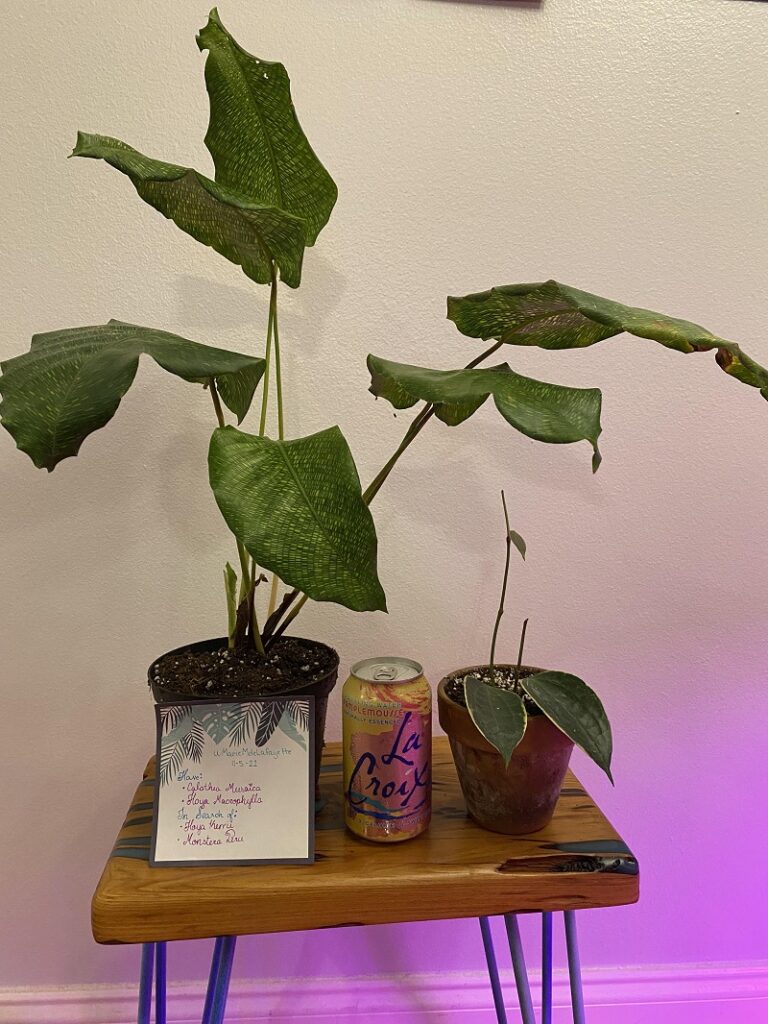Calathea Musaica (Network Plant) is the most beautiful tropical plant species due to its intricate foliages and ease of care routines. The minimal care requirements make this houseplant ideal for beginners.
The calathea musaica care includes bright indirect sunlight, 50-80% humidity, well-draining soil, and a moderate watering routine. It also thrives under a temperature range of 65-85oF (13-30oC) and feeding every 4-6 weeks during spring and summer.
Keep reading this article to learn everything about calathea musaica care. The information will help your houseplant to thrive throughout the year. You’ll also know how to resolve the numerous growing issues in the long run.
You Might Also Read: How to Care for Calathea Ornata (Pinstripe Plant)

What Does Calathea Musaica Looks Like?
The calathea musaica (network prayer plant) belongs to the Marantaceae family and is native to the Brazil rainforest. It is also among the rare calathea varieties in the world.
The stunning and attention-grabbing foliages make a bold statement in any space. The houseplant is understated and less beautiful according to in my opinion.
One of my favorite features is the ease of growing and maintaining. Besides that, the mid-green and mosaic pattern make this network plant interesting to add to the indoor plant collection.
The scientific name for this houseplant is Goeppertia kegeljanii, though it is sold under network or network prayer plant names. This charming houseplant grows up to 2 feet tall.
Other calathea varieties with close similarities to calathea musaica are makoyana, pinstripe, and orbifolia. The inappropriate growing condition causes leaf curling, drooping, and brown leaf tips.
Calathea Musaica Care Details
| Origin | Brazil |
| Family | Marantaceae |
| Scientific Name | Goeppertia kegeljanii |
| Common Names | Network plant Network prayer plant |
| Light Requirement | Bright indirect sunlight |
| Watering Needs | Frequent watering when the topsoil is dry |
| Soil Requirement | Well-draining potting soil |
| Temperature Range | 65-80oF (18-30oC) |
| Humidity Requirement | 50-80% Humidity level |
| Fertilizer Application | Use balance fertilizer every 4-6 weeks of spring and summer |
| Flowering | Doesn’t bloom indoors |
| Pruning | Remove dead foliages |
| Propagation | Rhizome division |
| Re-potting | Due to root bound issue |
| Pests and Diseases | Pests: spider mites, mealybugs, thrips, scales and fungus gnats. Diseases: root rot due to overwatering |
| Toxicity | Non-toxic |
How to Care for Calathea Musaica Plant
Calathea Musaica Light Requirements
Calathea musaica is tolerant to variable light conditions than other calathea varieties. The houseplant thrives in bright indirect sunlight.
I recommend placing the plant to direct sunlight early in the morning or late in the evening. The intensity will not harm or scorch the leaves.
Keep rotating the indoor plant in the presence of natural light to enhance balanced growth. Sufficient natural light keeps the plant healthy and foliages in excellent shape.
The north-east facing window is the best for the calathea musaica plant in summer and not winter. Keep an eye on the foliages to note any changes caused by light issues.
How to Water Calathea Musaica Plant
Calathea musaica loves moderate soil moisture. Too much moisture content might result in root rot and other fungal diseases.
I recommend inspecting the soil moisture before watering. Insert index finger in the topsoil to check if it is dry. Soak the soil with water if the topsoil is dry until it runs through drainage holes.
Place the houseplant in bright indirect sunlight to enhance maximum utilization of water. It also promotes faster soil dry to prevent delicate roots from root rot.
Inconsistent watering habits might also cause calathea musaica leaves to curl, droop, and turn yellow or brown. Keep an eye on the plant foliages and provide ultimate care.
Best Calathea Musaica Soil Mixture
The houseplant flourishes in well-draining potting soil with high-quality moisture retention. I recommend an equal mixture of perlite, gravel, and coarse sand.
Add compost and peat to improve soil fertility to enhance vegetative growth. Well-draining soil helps to improve drainage and reduce the risk of overwatering.
Calathea Musaica Humidity Requirements
Humidity is an essential factor of the calathea musaica care routine. It helps to keep the plant happy and healthy throughout the year.
This network prayer plant loves high humidity of about 60-80%. But the indoor plant can also tolerate an average humidity of 50%.
Low humidity results in excess water loss making the leaf edges and tips turn brown. Prolong exposure to low humidity might also cause leaf curling and stem falling over.
Use a digital hygrometer (Check Best Deals on Amazon) to monitor humidity changes. Install a humidifier (Check Best Deals on Amazon) to boost air moisture around the plant.
Best Calathea Musaica Temperature Range
Calathea musaica can thrive indoors under a temperature range of 65-85oF (18-30oC). The plant will stop growing when the temperature drops below 60oF.
Cold temperatures in winter force the houseplant to enter the dormancy phase. The houseplant ends up using fewer nutrients and water.
Both cold and hot drafts make the plant foliages curl, wilt, and turn brown. Keep your calathea musaica away from radiators, heaters, and windowsills in winter.
How to Fertilize Calathea Musaica
Calathea musaica plants do not need regular fertilizer application. But the nutrients keep the plant healthy and enhance vegetative growth.
Use water-soluble and well-balanced fertilizer. I recommend applying the fertilizer every 4-6 weeks in spring and summer.
You can also use homemade fertilizer instead of artificial fertilizer. Read my article on how to make homemade fertilizer for houseplants.
Calathea Musaica Flower
Indoor calathea musaica does not bloom. Besides that, the flowers on outdoor calathea musaica are not exciting. The plant produces white flowers with short stalks that last for a week.
The flowers emerge directly from the rhizome, and they are easy to overlook. I recommend snipping the bloom to conserve the plant energy.
Calathea Musaica Pruning
The network prayer plant requires minimal pruning care. Every houseplant enthusiast should remove dead or damaged leaves to conserve energy.
Use a sharp sterilized pruner (Check Best Deals on Amazon) to cut the dead leaves above the soil. Allowing dead leaves to decay in the potting soil will invite pests and diseases.
How to Repot Calathea Musaica
Calathea musaica plants have rhizomes as root systems. These rhizomes do expand over time (after 2-3 years) to foster the need for repotting.
Keep in mind that the houseplant is super sensitive to transplant shock. The good news is that this indoor plant can tolerate the root-bound issue.
Repotting is a good idea when propagating or it has overgrown the pot. Perform the task with ultimate gentle care to avoid disrupting the root systems.
Calathea Musaica Propagation
The best way to propagate a calathea musaica is by the division of a mature rhizome. Divide the rhizome into sections at the time of repotting.
The parent plant will experience some shock during the division. It will stop growing for a couple of months. But with ultimate care, it will survive in the long run.
Common Problems and Solutions
Pests
Calathea musaica is less vulnerable to pest infestation. But this does not make the plant invincible to some sap-sucking insects.
Mealybugs, spider mites, scales, aphids, and fungus gnats are some of the pests that attack the calathea musaica plant.
These pests occur due to improper plant care and can damage this houseplant. Keep the houseplant in good health to reduce the risk of insect infestations.
I recommend the use of insecticidal soap to eliminate these pests from the plan. Spray the soap solution on the plant weekly until the pests are eliminated.
Diseases
Calathea musaica plants are not vulnerable to any specific indoor plant diseases. But imperfect growing conditions can result in root rot and insect infestations.
Root rot occurs due to overwatering issues and insect infestations as a result of poor ventilation. Re-pot the houseplant suffering from root rot and provide perfect growing condition.
Frequently Asked Questions
Is Calathea Musaica Poisonous?
No. It is a non-toxic and safe plant for both humans and pets. But I recommend keeping it away from pets and toddlers for ultimate safety purposes.
Why Are My Calathea Musaica Leaves Turning Yellow?
When the entire leaves begin to turn yellow, the likely causes are overwatering and low light conditions. Root rot inhibits the intake of vital minerals and the absorption of water.
Besides that, potting soil with insufficient nutrients will make the leaves turn yellow due to malnourishment. Always apply fertilizer to the plant every 4-6 weeks of spring and summer.
Why Are My Calathea Musaica Leaves Curling?
Calathea musaica leaves curling to occur due to under-watering and exposure to heat drafts. Consider soaking the potting soil and keeping the houseplant away from heat drafts.
Insect infestation is another cause of calathea musaica leaves curling. These pests usually attack the foliages and suck vital nutrients causing the leaves to curl.
Why Are My Calathea Musaica Leaves Turning Brown?
Low humidity level makes the calathea musaica leaf tips and edges turn brown. Besides that, too much direct sunlight scorches the leaves to result in brown color.
I recommend installing a humidifier to boost humidity around the plant and place it in an area that receives bright indirect sunlight. Use distilled water or rainwater to irrigate the houseplant.
Why Is My Calathea Musaica Droopy?
Heat draft is the leading cause of musaica drooping. The high temperature facilitates faster water loss and makes the stems fall over.
Inconsistent watering is another possible cause of calathea musaica drooping. A dehydrated plant will always fall over and die if the condition persists.

Final Word
How to care for the calathea musaica plant entails the provision of bright indirect sunlight, well-draining soil, high humidity, and a temperature range of 65-85oF.
Be sure to use rainwater or distilled water when watering the houseplant. calathea musaica foliages are super sensitive to minerals.
Calathea musiaca care routine is a no-brainer task and can be undertaken by beginners. Proper plant care enhances healthy growth and vegetative appearance.
